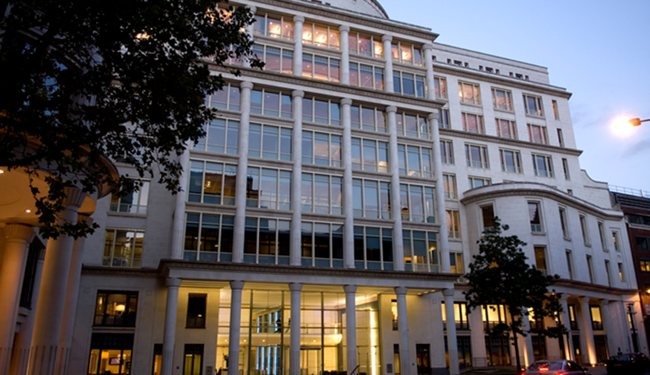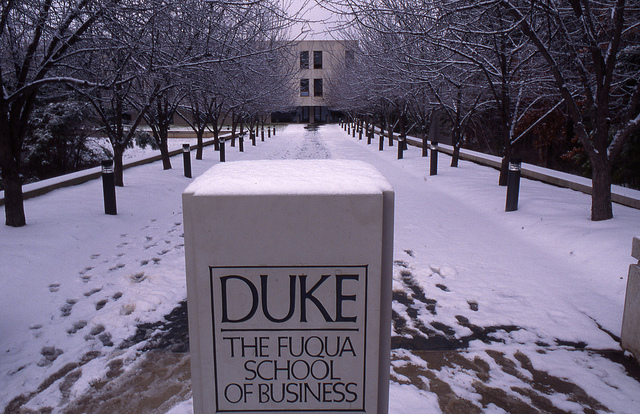
Chicago Booth
The Booth School of Business is known for being first. In 1943, it launched the world’s first Executive MBA program. Forty years later, the University of Chicago became the first business school to boast a Nobel Prize winner on its faculty. More recently, the school accepted a $300 million gift from its namesake – the largest gift of its kind.
Booth is a pioneer. Not only does it point the way, but it helps to set the bar, too. That’s one reason why Booth repeated as the top American EMBA program, according to a new 2016 composite ranking by Poets&Quants.
Finishing among the top three programs in each of the EMBA rankings by U.S. News, the Financial Times, and The Economist, Booth boasted a near-perfect 98.9 score, edging out cross-town rival Northwestern by the closest of margins. In the process, Columbia Business School climbed two spots to third.
LOSS OF BUSINESSWEEK EMBA RANKING SHAKES UP THE TRADITIONAL ORDER
Notice an omission? There was quite a sizable one: Bloomberg Businessweek discontinued its bi-annual EMBA ranking in 2015. Drawing on results from two surveys, Businessweek’s ranking equally balanced the satisfaction of graduating EMBAs with the opinions of EMBA directors using three years of data. In the last ranking – published in 2013 – Kellogg had actually replaced Booth at the top spot, with SMU (Cox), Wharton, and UCLA (Anderson) rounding out the top five.
How much of an impact did removing this ranking make? In P&Q’s 2014 EMBA ranking, which included Businessweek’s rankings among the composite, USC Marshall ranked 9th among American programs, which was bolstered by a 8th place finish with Businessweek. In P&Q’s 2016 ranking, Marshall tumbles all the way to 29th, a decline largely caused by USC’s exclusion from both the 2015 rankings by the Financial Times and The Economist. The University of North Carolina’s Kenan-Flagler Business School suffers a similar fate. Like Marshall, Kenan-Flagler was unranked by both the Financial Times and The Economist in 2015. As a result, losing its 8th place ranking in Bloomberg Businessweek sinks Kenan-Flagler from being a Top 10 American EMBA program down to 25th.

Duke University’s Fuqua School of Business
A RANKING THAT COMES WITH ASTERISKS
However, Wharton experienced the worst loss thanks to Businessweek’s departure from the EMBA stage. The runner-up to Booth in P&Q’s 2014 EMBA ranking, Wharton ranked 1st and 2nd respectively with U.S. News and the Financial Times. However, the Wharton MBA For Executives isn’t ranked by The Economist (almost certainly by choice). As a result, Wharton sacrifices potentially a third of its index points, making it virtually impossible for its EMBA program to rank any higher than 10th on P&Q’s metrics. If Wharton had ranked 10th with The Economist (a near lock), Wharton would actually rank just behind Booth and Kellogg. As a result, Wharton’s 2016 ranking comes with an asterisk attached.
And the same applies to Duke University’s Fuqua School of Business. Here is how respected Fuqua’s EMBA program is: It is one of only six programs (Booth, Kellogg, Columbia, Stern, and Wharton being the others) that’s ranked among the top ten programs with both U.S. News and the Financial Times (finishing 6th and 3rd respectively). However, like Wharton, Fuqua isn’t listed among The Economist’s Top 62 EMBA programs globally (with the school telling P&Q that it has never participated in The Economist’s ranking). You can probably guess the result. Fuqua is relegated to 11th in P&Q’s 2016 EMBA ranking. Insert a 10th place placeholder for Fuqua with The Economist and the program ranks just behind Columbia in 4th. Again, we placed an asterisk alongside Fuqua’s EMBA ranking to reflect it should be ranked much higher.
MANY METROS BOAST TWO ACCLAIMED EMBA PROGRAMS
Despite these wrongs, one theme emerges from this year’s ranking: The best things come in pairs. Like a yin to a yang, many large metros sport two leading EMBAs, including Chicago (Booth and Kellogg), New York City (Columbia and Stern), the District of Columbia (Smith and McDonough), the Research Triangle (Fuqua and Kenan-Flagler), and Atlanta (Georgia and Emory).
Ranking first and second, Booth and Kellogg have turned the Windy City into the epicenter of the American EMBA scene (and that doesn’t include Notre Dame’s Michigan Avenue EMBA campus).
So what separates the schools? Start with the basic inputs. For one, Kellogg’s program is more U.S.-centric, with 68% of the 2016 Class hailing from the United States (followed by 14% from South America and 7% from Asia). Booth, which factors its campuses in Chicago, London, and Hong Kong into the mix, is more cosmopolitan by contrast, with just 29% of its newest class based in the United States. In fact, Booth reports that this class features students from 56 countries. At both schools, the average age is roughly 37 years with 13 years of experience. Students also arrive with similar pre-MBA salaries ($172,444 at Kellogg and $171,712 at Booth) according to The Economist. That said, Kellogg EMBAs brought 11 years of management experience to the classroom, according to The Economist, against 8 years at Booth That may be one explanation why Kellogg is slightly more expensive at $187,200 in tuition and fees (vs. $179,000 at Booth).
IS KELLOGG THE TRUE #1 EMBA PROGRAM?
Outputs are decidedly mixed. Based on the Financial Times’ collection of compensation data from the Class of 2010, Kellogg EMBA grads earn more within three years of graduation ($239,190 vs. $231,232) and enjoy bigger salary increases (53% vs. 51%) – with The Economist data showing similar results. Booth EMBAs, however, experienced faster career progress after graduation. According to The Economist, 57.5% of Booth questionnaire respondents (which came from a pool of 7,000 EMBAs globally) had received a promotion within two years of earning their MBA, compared to 52.6% of Kellogg respondents. Not to mention, Booth graduates ranked 28th in the Financial Times’ in career progress compared to 48th by Kellogg grads.





Questions about this article? Email us or leave a comment below.